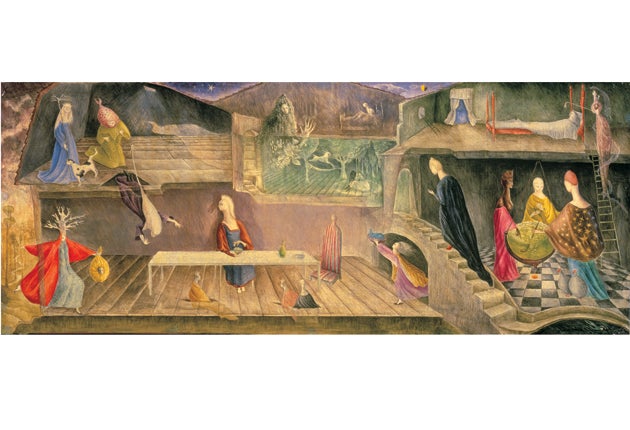Surreal Friends, Pallant House Gallery, Chichester
Feel at home with the last Surrealist

Over-interpret the work of Leonora Carrington, and the woman who could reasonably be called the last of the Surrealists will turn upon you.
Art takes place only in the space where it appears, she argues. Well, she may say that, and let us hope that we shall all be as mischievous at 93. But a single glance at her work in Surreal Friends is enough to trip any viewer into the interpretative trap.
You can hardly go to finishing school in Florence with a flair for art, as Carrington did, and not come away fluent in the language of the Renaissance. Thus the images that stand out from Surreal Friends: Leonora Carrington, Remedios Varo and Kati Horna are biblical in all but name. Scenes recalling the Nativity, the parables, the narrative predellas of altarpieces are in intriguing contrast to the story of a rebel who ran away from her well-heeled Lancashire home, took up at 23 with the 46-year-old Max Ernst, and landed up in the safe haven of Mexico after a hair-raising zig-zag escape from fascism.
It is in Mexico still that she is most lauded, but this touring exhibition helps to place her among the Surrealists generally, and the British movement in particular. And her distinctive characteristic, in that genre, is a warm and playful charm.
The British Surrealists had a flair for jollity – the picnics and parties may have pushed the boundaries, but photographs, such as Lee Miller's portrait of Carrington and Ernst, speak of simple bliss. And Carrington likes images that make you smile – the lean, lingering cats in the fable Tuesday, the high-speed domesticity of The House Opposite. And while the influence of Bosch is clear, on canvases teeming with fantastical creatures, most are benign.
Most beatific of all is The Guardian of the Egg, a resonant hymn to creation, its corn-haired giantess gently cradling one tiny, delicate egg as living things dart around the great, white-cloaked Earth mother.
Grandmother Moorhead's Aromatic Kitchen, in which a table of exotic vegetables is presided over by a colossal white bird, makes reference to the family connection that helped to make this exhibition possible. The journalist Joanna Moorhead, a cousin by marriage of Carrington, pieced together this family story and co-curates the exhibition with Pallant House director Stefan van Raay. Since Carrington has been less collected in Britain than in her adopted land, many of the pieces have been prised out of private collections. We are unlikely to see them again. And that gives this show its special allure. While we are beyond saturation point with other, in some cases lesser, Surrealists, this rare excursion into an underrated vision is a beguiling one.
The contribution of fellow exiles and artists Remedios Varo and Kati Horna helps to flesh out the story; indeed, the photograph by Horna of Varo wearing a mask designed by Carrington neatly distils the essence of the three friends. Varo's Creation of the Birds has the kindly wit of Carrington's egg guardian, as a new bird is lovingly handcrafted. Horna records the devastation of the Spanish civil war. All three have a way of seeing that does what good art should – makes us look at our own little world anew.
Pallant House, Chichester (01243-774557) to 12 Sep, then Sainsbury Centre, Norwich (01603-593199), 28 Sep to 12 Dec
Join our commenting forum
Join thought-provoking conversations, follow other Independent readers and see their replies
Comments
Bookmark popover
Removed from bookmarks